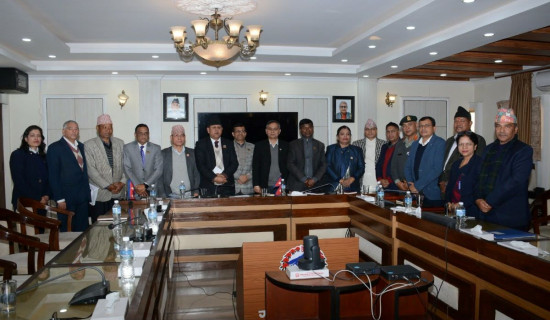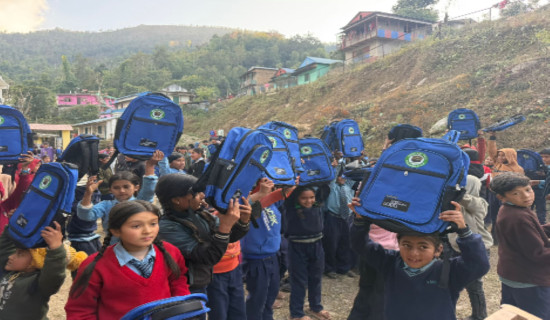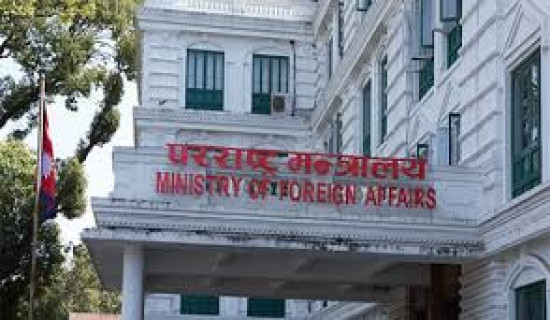- Monday, 5 January 2026
China’s Bamboo Industry Reliable Means Of Rural Revitalisation
It is imperative for the Nepali government to bring in capital and technology from China for establishing bamboo industry given that the northern neighbour has made big strides in the research, development, and innovation of bamboo cultivation, processing, and production.
Depth, nuance, and precision. Yes, one can see these qualities running in artisans making beautiful products from the bamboo stems. At a corner of the Bamboo Art and Museum Centre at Qingshen County in the southwest of China's Sichuan Province, four female crafts workers were busy splitting bamboo stalks and extracting thousands of threads out of them. Their meticulous labour was not only attention-grabbing but also engaging. Visitors from Nepal in no time joined them in taking layers and creating fibres from the bamboo culm. Smiling and receptive, the craft workers taught them some skills to weave the bamboo pieces into art works.
“Oh! That’s incredible. What a beautiful fish!” exclaimed Nepali visitors when the craft workers presented bamboo-woven fish to them within a minute. And all Nepali delegates kept colourful bamboo fish as the token of love of Qingshen, known as the ‘hometown of bamboo weaving in China.’ The inspection tour at the centre was a part of the workshop ‘Bamboo Industry and Rural Revitalisation’ organised by the Jinjiang College, Sichuan University, Chengdu, in the third week of this September.
Also recognised as the ‘national intangible cultural heritage production protection base’, Qingshen boasts of its more than 5,000-year-long history in bamboo weaving. The traditionally inherited bamboo weaving practice has now been developed into a robust green industry, producing 3,000 products in 25 categories and exporting them to more than 50 countries.
Run under the administration of the prefecture-level city of Meishan, Qingshen has not only made bamboo as a viable means of poverty alleviation but has also engaged the international community in promoting its production and products. It has successfully organised five editions of China International Bamboo Industry Trade Expos since 2018. This may be the reason why it has earned the appellation of ‘international bamboo weaving capital’.
Bamboo is the multipurpose non-wood plant that grows so fast that some species get taller by three feet in a single day. The raw bamboo is processed in pulp factories, which convert wood chips or other plants into a thick fibre. According to sciencedirect.com, ‘large bamboo poles are cut into strips and stacked with the grain at right angles, and the assembled strips are impregnated with a low VOC resin and pressed and cured. The produced board is milled and sanded to give finished panels.’ Bamboo forests have the ability to absorb carbon dioxide, helping to mitigate climate change effects, while bamboo wood is not only ecologically friendly but also a viable substitute for hardwood.

Bamboo epiphany!
For us, visiting Qingshen County was like going through ‘bamboo epiphany.’ In Nepal, we have seen only bamboo handicrafts and some furniture items. But here, we felt, ‘What cannot be made out of bamboo?’ We saw everywhere bamboo and its products—from the bamboo grove to furniture, flooring, beds, artworks, baskets and bowls to clothing, and from utensils, paper, and tissue paper to medical materials, road dividers, and houses. Inside the restaurant, we savoured bamboo tea, soup, pickles, and vegetables. Environmentally conscious consumers and companies prefer bamboo products, though they are slightly more expensive than non-bamboo products.
In 2023, the Chinese government joined hands with the International Bamboo and Rattan Organisation (INBAR) to launch a global action plan for promoting bamboo as a substitute for plastic. The campaign has set six goals and 23 specific actions. This is a reason why bamboo and its products can be seen everywhere in Qingshen County.
At the entry of Langoliclin, China’s number one bamboo weaving village located in Qingshen, stands an attractive three-floor house. At first sight, one may not believe that it can be built with refined bamboo materials. This showed even a big house can be erected using bamboo pillars and planks. "It was an old, derelict house. In 2020, the government decided to reconstruct it using bamboo wood and materials. As a result, it was restored to the present shape," said Gloria Liu, a Chinese participant in the programme. Every house, made of bamboo products, has become a model to demonstrate the strength and aesthetic values of bamboo. Some serve as teahouses, while others showcase bamboo art and souvenirs.
Langoliclin also hosts the famous Zhuli Alley that thrives on the back of bamboo industry and village resources. It promotes policy incentives and explores a new path of integration, industrial development, and ecological living through the five-word work method of "demolition, collection, renovation, planting, and painting." However, this involves the government's decision-making and planning, unified circulation of village collective organisations, demonstration and drive of the county's state-owned platform companies, and mobilisation of social capital.
The Alley has evolved as a template of rural revitalisation while driving the entire county to build more than 50,000 "four small gardens," with a goal of making the village clean, green, and beautiful. Covering an area of 19,000 square meters, it features the old well square, gorgeous flower mirror, bamboo forest space, food alley, and other landscape joints.
Source of Southern Silk Road
There is a popular saying: ‘Chinese bamboo weaving looks at Sichuan; Sichuan bamboo weaving looks at Qingshen.’ Yes, Qingshen bamboo has become a representative of China’s cultural heritage that has spread to different corners of the world since ancient times.
As a source of the Southern Silk Road, Qingshen had maintained close cultural exchanges and cooperation with Southeast Asia and other countries and regions along the Maritime Silk Road. The road of ancient Shu went down the Minjiang River and then the Yangtze River before sailing to the world from the sea. The Qingshen man used bamboo baskets and mats to carry the special products of Sichuan while applying the bamboo mats for the sheltering of large wooden boats. Qingshen County has set up intangible cultural heritage exchange centres and overseas bamboo art training centres in Belt and Road Initiative (BRI) partner countries and regions. They have provided training to over 10,000 people from more than 30 countries as part of promoting green development.
Vehicle of economic empowerment
Focusing on the characteristic bamboo industry, Qingshen County created more than 50 national forestry-leading enterprises. Up to now, the area of bamboo forest in the county has reached 200,000 mu (13,333.33 hectares), and the comprehensive output value of bamboo industry is USD 1.12 billion. At present, there are 15,000 people working in the bamboo industry in the county. One person earns 2,000 yuan a month by planting bamboo forests, weaving bamboo silk, and holding bamboo conferences.
Bamboo industries also involve the local communities in decision-making processes with regard to the cooperative farming and production of bamboo. By promoting bamboo as an eco-friendly alternative, rural people have contributed to protecting their natural resources while meeting the growing demand for sustainable construction materials. Bamboo forests have a positive impact on the environment, culture, economy, and sustainability.

The county has been hosting the annual international bamboo fairs to promote bamboo products and share knowledge and skills among the participating countries. Many countries, including Nepal, have been participating in the fair that has become a platform of innovation, culture, and ecological awareness. “It provides countries an opportunity to showcase their bamboo-related products and innovations, fostering an exchange of ideas and practices that promote sustainability,’ said an official of Qingshen County.
As the largest manufacturer and exporter of bamboo products, China exported 56,709,823 kg of bamboo woven products in 2023, with an export value of USD 178,305,323 and an import volume of 120,104 kg worth USD 1,308,360. China has 837 species of bamboo. Its forests cover 7.56 million hectares of land that produce more than 150 million metric tonnes of bamboo annually, according to a news report from CGTN. Over 29 million people work in bamboo enterprises across China. There are 10,000 bamboo processing factories. Its output value has surpassed 410 billion yuan ($57 billion) in 2023 from 82 billion yuan ($11 billion) in 2010.
The investment in bamboo industry has been a part of the China rural revitalisation strategy adopted by the 19th National Congress of the Communist Party of China (CPC) in 2017. It focuses on rural reconstruction and governance so that those who were lifted out of extreme poverty would not relapse into the cycle of destitution.
China ready to support Nepal
A Qingshen County official noted that Nepal, with a rich tradition of utilising bamboo, had been taking part in the fair to showcase its diverse range of bamboo products. Nepali artisans presented their unique creations, from handicrafts to construction materials, that highlighted both the cultural significance and practical uses of bamboo, he said, adding that the Chinese government was ready to collaborate with Nepal on the production and manufacturing of various bamboo items.
“Sichuan and Nepal have maintained close exchanges in economy, trade, education, and culture,” said Yan Shijing, president of Sichuan University Jinjiang College. He noted that the workshop had built a platform for communication between Sichuan and Nepal in rural revitalisation and development.
In Nepal, the people, especially in rural areas, have been earning good money by weaving and selling various types of bamboo baskets such as doko, dalo, nanglo and bhakari for centuries. There are also bamboo enterprises that have been producing sofas, beds, handicrafts, parquets, cupboards, tables, mats, and flooring on a limited scale, as they are yet to transform their ventures into industry-level.
"In the absence of capital, technology, human resources, and markets, we have not succeeded in upgrading our bamboo enterprises into large-scale industries," said Basu Bhandari of Himalayan Bamboo Private Limited (HBPL), which was set up in 2000. The HBPL also used to export bamboo-made parquets to the USA, but now its products are supplied only inside the country. However, Nepal spends a huge amount of money importing bamboo products, including tooth brushes, tea cups, plates, and kitchen items. HBPL is associated with INBAR, GTZ, and the World Bank and receives technical cooperation from them.
Pranab Pradhan, founding chairman of Green Bamboo Creations, said that the income of the rural people could be increased and the import of bamboo products reduced if farmers got engaged in commercial farming of bamboo.
It is worth mentioning here that China had provided technical support to Nepal for establishing processing units for bamboo industries in 2010. It had given the seed of moso (Phyllostachys edulis), an advanced species of bamboo, to Nepal in 2015. It is produced in large plantations and harvested for various types of products such as timber, plywood, utensils, and fencing. This species is suitable for the country’s climate and is commercially cultivated in community forests in Banepa of Kavrepalanchok and other parts of the country. With a view to promoting bamboo cultivation and production, the first 'National Bamboo Conference' is going to be held in Khotang, in east Nepal, in February.
It is imperative for the Nepali government to bring in capital and technology from China for establishing bamboo industry given that the northern neighbour has made big strides in the research, development, and innovation of bamboo cultivation, processing, and production. “There is a huge prospect of cooperation between China and Nepal on the bamboo industry that can be a viable means of livelihood for Nepali people,” said professor Yang Shaoping of Jinjiang College. He said that his office was ready to facilitate communication with relevant Chinese departments if the Nepali side came up with an appropriate proposal for this.
(Subedi is Deputy Executive Editor and Kafle reporter of this daily.)



-original-thumb.jpg)
-square-thumb.jpg)










-original-thumb.jpg)
